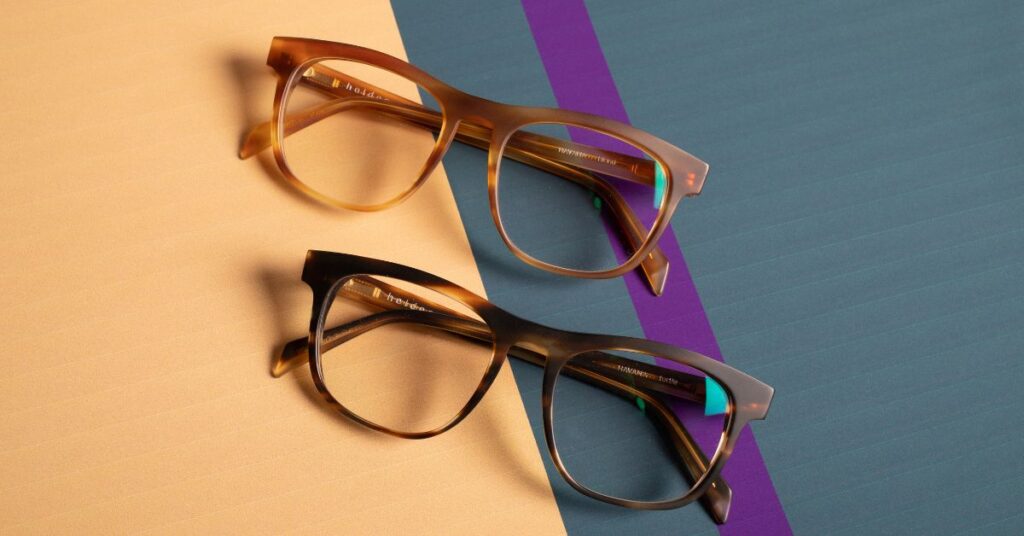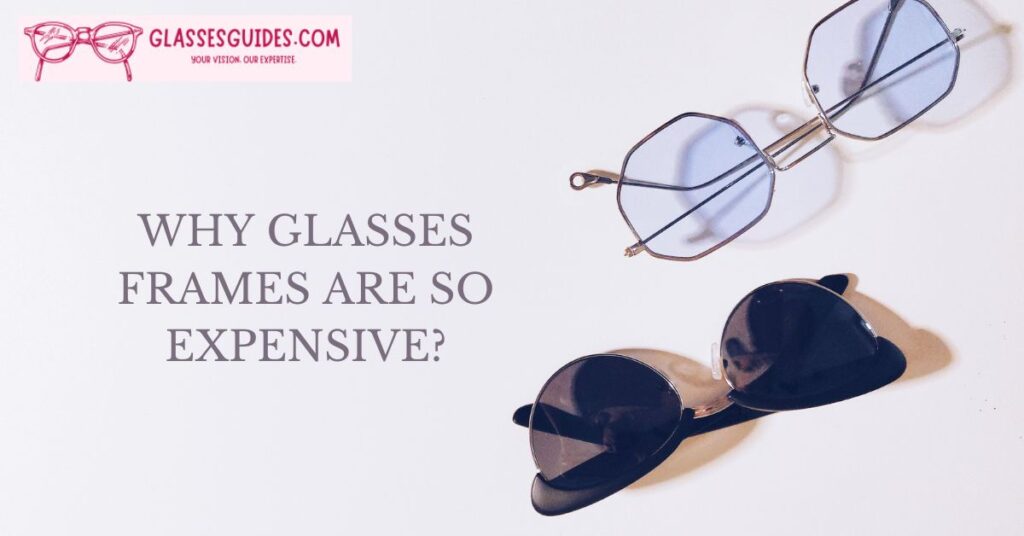Hi there! Ever wonder why it seems like glasses frames cost an arm and a leg? You’re not by yourself. It’s a typical query that a lot of us have thought about at some point. We’re delving into the realm of eyewear in this piece to find out why those reasonably priced, seemingly basic frames cost so much.
Watch on as we solve the puzzle of why glasses frames are so expensive, whether you’re shopping for a new pair or you’re just interested in the economics of eyewear. Let’s discuss this sometimes disregarded facet of our daily necessities.
Table of Contents
1. Materials Matter
Ever noticed how some glasses frames feel sturdier or more luxurious than others? That’s because the materials used in their construction play a big role in both their durability and their cost. From lightweight titanium to durable acetate and high-quality metals, the materials used in glasses frames can vary widely in terms of both quality and price.
- Titanium: This lightweight and hypoallergenic metal is a favorite among eyewear designers for its strength and flexibility. However, the cost of sourcing and working with titanium can be higher, driving up the price of frames made from this material.
- Acetate: Often used in high-end frames, acetate is a type of plastic known for its durability and wide range of color options. While acetate frames can be more affordable than those made from metal or titanium, the cost of crafting them to exact specifications can still contribute to their overall price.
- High-Quality Metals: Frames crafted from materials like stainless steel or premium alloys offer a balance of durability and style. However, the cost of these metals, as well as the precision engineering required to shape them into frames, can add to their price tag.

2. Design and Branding
Ever wondered why some glasses frames seem to carry a designer label and a hefty price tag to match? It’s all about design and branding. Let’s break it down:
- Designer Appeal: Just like with clothing or accessories, certain eyewear brands carry a cachet of luxury or style. Frames bearing a designer name often command higher prices due to their association with fashion trends, prestige, and exclusivity.
- Aesthetic Value: Design plays a crucial role in the pricing of glasses frames. Frames with intricate designs, unique shapes, or custom detailing require more time and craftsmanship to produce, driving up their cost.
- Perceived Value: Consumers are often willing to pay more for frames that they perceive as high-quality or fashionable. This perceived value is influenced by factors like brand reputation, celebrity endorsements, and advertising efforts.
- Branding Costs: Behind every designer frame, there’s a team of marketers, designers, and brand managers working tirelessly to maintain its image and appeal. These costs, including advertising, licensing fees, and brand ambassadorships, all contribute to the final price of the frames.
Further reading: What to do with old glasses?
3. Manufacturing Processes
Have you ever stopped to think about how your glasses frames are made? It turns out that the manufacturing process plays a significant role in determining their cost. Let’s take a closer look:
- Precision Crafting: Crafting glasses frames is a meticulous process that involves cutting, shaping, and assembling various components with precision. Skilled artisans use specialized machinery and tools to ensure that each frame meets exact specifications, which adds to the production costs.
- Quality Control: Ensuring the quality of each pair of glasses frames requires rigorous testing and inspection at every stage of the manufacturing process. From checking the fit and finish to testing for durability and comfort, quality control measures help maintain the integrity of the final product but also contribute to its cost.
- Customization Options: Many glasses frames offer customization options, allowing customers to choose specific colors, finishes, or lens shapes to suit their preferences. While this level of personalization adds value for the consumer, it also increases the complexity and cost of manufacturing.
- Eco-Friendly Practices: As sustainability becomes a growing concern in manufacturing, some eyewear brands are investing in eco-friendly materials and production processes. While these practices may come with higher upfront costs, they reflect a commitment to environmental responsibility and can influence the final price of frames.

4. Research and Development
Behind every pair of glasses frames lies a considerable amount of research and development (R&D) investment. Here’s why it matters:
- Innovation and Technology: Eyewear companies are constantly striving to innovate and improve their products. This involves investing in research to develop new materials, technologies, and manufacturing processes that enhance the quality, durability, and comfort of glasses frames.
- Product Testing: Before frames hit the market, they undergo extensive testing to ensure they meet stringent quality and safety standards. This includes testing for durability, impact resistance, and compatibility with various lens types. The costs associated with product testing and certification contribute to the overall price of frames.
- Design Iterations: Designing a new pair of glasses frames often requires multiple iterations and prototypes to refine the aesthetics, fit, and functionality. This iterative design process involves collaboration between designers, engineers, and opticians to create frames that not only look great but also perform well in real-world conditions.
- Consumer Feedback: Companies also invest in gathering feedback from consumers to understand their preferences, needs, and pain points. This feedback loop informs future product development efforts and helps ensure that glasses frames meet the evolving demands of customers.
Further reading: How To Find My Glasses?
5. Distribution and Retail Markup
Once glasses frames are manufactured, they go through a series of distribution channels before reaching consumers. Here’s how the distribution and retail markup contribute to their cost:
- Wholesalers and Distributors: After production, glasses frames are typically sold to wholesalers or distributors who then sell them to retailers. Each step in the distribution chain adds a markup to the frames’ cost to cover overhead expenses and generate profit for the intermediary.
- Retailers: When glasses frames finally reach retail stores or online outlets, another markup is added to cover operating costs such as rent, staff salaries, and marketing expenses. Additionally, retailers aim to make a profit margin on each sale, which further increases the final price paid by consumers.
- Brand Boutiques and Luxury Retailers: In the case of designer frames or premium eyewear brands, frames may be sold through brand-owned boutiques or luxury retailers. These outlets often command higher prices due to their exclusive ambiance and personalized customer service.
- Discounts and Promotions: While retail markup can contribute to the perceived cost of glasses frames, consumers can often find discounts or promotions that help mitigate these markups. Sales events, loyalty programs, and online coupons are common ways for retailers to offer frames at lower prices.

6. Healthcare and Insurance Factors
The cost of glasses frames can also be influenced by healthcare systems and insurance coverage. Here’s how:
- Insurance Coverage: In many countries, health insurance plans may partially or fully cover the cost of prescription eyewear, including frames. However, coverage limits, copayments, and deductibles can vary significantly between insurance plans. Some plans may only cover basic frames, leaving consumers to pay out of pocket for designer or specialty frames.
- Out-of-Pocket Expenses: Even with insurance coverage, consumers may still face out-of-pocket expenses when purchasing glasses frames. This can include copayments, coinsurance, or expenses for frames that exceed the coverage limits set by their insurance plan.
- Limited Options: Insurance plans often have contracts with specific eyewear providers or networks, limiting consumers’ choices when it comes to where they can purchase frames. This lack of competition can contribute to higher prices, as consumers may not have the option to shop around for the best deal.
- Affordability Concerns: For individuals without insurance coverage or with limited financial means, the cost of glasses frames can be a significant barrier to accessing necessary vision correction. Some charitable organizations and government programs offer assistance programs or subsidies to help low-income individuals afford eyewear.
Further reading: How to clean cloudy eyeglasses?
7. Consumer Perception and Demand:
Consumer perception and demand play a crucial role in determining the pricing of glasses frames. Here’s why:
- Fashion Trends: Like other fashion accessories, glasses frames are subject to trends and preferences. Frames that align with current fashion trends or celebrity endorsements often command higher prices due to increased demand.
- Brand Reputation: Established eyewear brands or designer labels carry a sense of prestige and quality that can influence consumer perception. Frames associated with well-known brands may be perceived as higher quality and thus justify a higher price tag.
- Peer Influence: Social factors, such as peer recommendations or influencer endorsements, can sway consumer purchasing decisions. Individuals may be willing to pay more for frames that are popular among their social circles or endorsed by influencers they admire.
- Perceived Value: Ultimately, the price consumers are willing to pay for glasses frames is often tied to their perceived value. Factors such as design aesthetics, comfort, durability, and brand reputation all contribute to how consumers perceive the value proposition of a pair of frames.
- Limited Supply: In some cases, frames may be produced in limited quantities or as part of exclusive collections, driving up demand and prices. Limited availability can create a sense of urgency among consumers, leading them to be willing to pay higher prices to secure a coveted pair of frames.
Summary
As we wrap up our exploration into why glasses frames are so expensive, it’s clear that a variety of factors contribute to their pricing. the high cost of glasses frames stems from a combination of factors, including the quality of materials, intricate manufacturing processes, design and branding, distribution markups, healthcare influences, and consumer perception. While premium materials and designer labels may drive up prices, understanding these factors empowers consumers to make informed decisions.
By balancing style, comfort, and affordability, individuals can find frames that meet their needs without breaking the bank. Ultimately, the best glasses frames are those that not only enhance vision but also reflect personal style and confidence. Keep exploring and discovering the perfect pair that fits your unique preferences and budget.
FAQ: Why glasses frames are so expensive?
Are designer frames worth the higher price?
It depends on your priorities. Designer frames often boast superior craftsmanship, unique designs, and brand prestige, which some individuals find worth the investment. However, there are plenty of high-quality, affordable options available that offer comparable style and functionality.
Can I save money by buying glasses frames online?
Yes, purchasing glasses frames online can often be more affordable due to lower overhead costs for online retailers. Just be sure to research the company’s reputation, and return policy, and ensure accurate measurements for a proper fit.
Are there ways to reduce the cost of glasses frames?
Yes, several strategies can help lower the cost of glasses frames, such as opting for frames made from more affordable materials, choosing basic designs over intricate ones, taking advantage of discounts or promotions, and exploring insurance coverage or assistance programs.
How can I ensure I’m getting the best value for my money when buying glasses frames?
To get the best value, consider factors such as comfort, durability, style, and affordability. Compare prices from different retailers, read customer reviews, and ask about warranty or satisfaction guarantees to ensure you’re making a well-informed decision.



